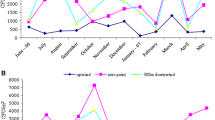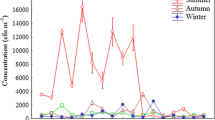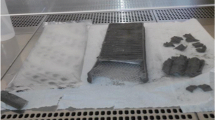Abstract
High loads of fungi have been reported in different types of waste management plants. This study intends to assess fungal contamination in one waste-sorting plant before and after cleaning procedures in order to analyze their effectiveness. Air samples of 50 L were collected through an impaction method, while surface samples, taken at the same time, were collected by the swabbing method and subject to further macro- and microscopic observations. In addition, we collected air samples of 250 L using the impinger Coriolis μ air sampler (Bertin Technologies) at 300 L/min airflow rate in order to perform real-time quantitative PCR (qPCR) amplification of genes from specific fungal species, namely Aspergillus fumigatus and Aspergillus flavus complexes, as well as Stachybotrys chartarum species. Fungal quantification in the air ranged from 180 to 5,280 CFU m−3 before cleaning and from 220 to 2,460 CFU m−3 after cleaning procedures. Surfaces presented results that ranged from 29 × 104 to 109 × 104 CFU m−2 before cleaning and from 11 × 104 to 89 × 104 CFU m−2 after cleaning. Statistically significant differences regarding fungal load were not detected between before and after cleaning procedures. Toxigenic strains from A. flavus complex and S. chartarum were not detected by qPCR. Conversely, the A. fumigatus species was successfully detected by qPCR and interestingly it was amplified in two samples where no detection by conventional methods was observed. Overall, these results reveal the inefficacy of the cleaning procedures and that it is important to determine fungal burden in order to carry out risk assessment.



Similar content being viewed by others
References
Alastruey-Izquierdo, A., Mellado, E., Peláez, T., Pemán, J., Zapico, S., Alvarez, M., Rodríguez-Tudela, J. L., & Cuenca-Estrella, M. (2013). Population-based survey of filamentous fungi and antifungal resistance in Spain. Antimicrobial Agents and Chemotherapy, 57(7), 380–3387.
Albercht, A., Kiel, K., & Kolk, A. (2007). Strategies and methods for investigation of airborne biological agents from work environments in Germany. International Journal of Occupational Safety and Ergonomics, 13(2), 201–213.
Alborch, L., Bragulat, M. R., Castellá, G., Abarca, M. L., & Cabañes, F. J. (2012). Mycobiota and mycotoxin contamination of maize flours and popcorn kernels for human consumption commercialized in Spain. Food Microbiology. doi:10.1016/j.fm.2012.04.014.
Allermann, L., & Poulsen, O. M. (2000). Inflammatory potential of dust from waste handling facilities measured as IL-8 secretion from lung epithelial cells in vitro. The Annals of Occupational Hygiene, 44(4), 259–269.
Amann, R. I., Ludwig, W., & Schleifer, K. H. (1995). Phylogenetic identification and in situ detection of individual microbial cells without cultivation. Microbiological Reviews, 59, 143–169.
American Conference of Governmental Industrial Hygienists. (1989). Guidelines for the assessment of bioaerosols in the indoor environment. Cincinnati, Ohio: American Conference of Governmental Industrial Hygienists.
Beaumont, F. (1988). Clinical manifestation of pulmonary Aspergillus infections. Mycoses, 31, 15–20.
Bellanger, A. P., Reboux, G., Murat, J. B., Bex, V., & Millon, L. (2010). Detection of Aspergillus fumigatus by quantitative polymerase chain reaction in air samples impacted on low-melt agar. American Journal of Infection Control, 38, 195–198.
Bernstein, R. S., Sorensen, W. G., Garabrant, D., Reaux, C., & Treitman, R. D. (1983). Exposure to respirable, airborne Penicillium from a contaminated ventilation system: clinical, environmental and epidemiological aspects. American Industrial Hygiene Association Journal, 44, 161–169.
Bornehag, C. G., Sundell, J., Bonini, S., Custovic, A., Malmberg, P., Skerfving, S., Sigsgaard, T., & Verhoeff, A. (2004). Dampness in buildings as a risk factor for health effects, EUROEXPO: a multidisciplinary review of the literature (1998–2000) on dampness and mite exposure in buildings and health effects. Indoor Air, 14, 243–257.
Bünger, J., Antlauf-Lammers, M., Schulz, T., Westphal, G., Müller, M., Ruhnau, P., & Hallier, E. (2000). Health complaints and immunological markers of exposure to bioaerosols among biowaste collectors and compost workers. Occupational and Environmental Medicine, 57, 458–464.
Carlile, M. J., Watkinson, S. C., & Gooday, G. W. (2001). The fungi. London, England: Academic.
Cruz-Perez, P., Buttner, M. P., & Stetzenbach, L. D. (2001a). Detection and quantitation of Aspergillus fumigatus in puré culture using polymerase chain reaction. Mol Cell Probes, 15, 81–88.
Cruz-Perez, P., Buttner, M. P., & Stetzenbach, L. D. (2001b). Specific detection of Stachybotrys chartarum pure culture using quantitative polymerase chain reaction. Molecular and Cellular Probes, 15, 129–138.
Degen, G. H., Blaskewicz, M., Lektarau, Y., GrLiner, C. (2003). Ochratoxin A Analyses of blood samples from workers at waste. Mycotoxin Research. Vol. 19.
De Hoog, C., Guarro, J., Gené, G., & Figueiras, M. (2000). Atlas of clinical fungi. 2nd. ed. Utrecht: Centraalbureau voor Schimmelcultures.
Douwes, J., Thorne, P., Pearce, N., & Heederik, D. (2003). Bioaerosol health effects and exposure assessment: progress and prospects. Annals of Occupational Hygiene, 47, 187–200.
Duquenne, P., Simon, X., Koehler, V., Goncalves-Machado, S., Greff, G., Nicot, T., & Poirot, P. (2012). Documentation of bioaerosol concentrations in an indoor composting facility in France. Journal of Environmental Monitoring, 14, 409–419.
Duchaine, C., & Meriaux, A. (2001). The importance of combining air sampling and surface analysis when studying problematic houses for mold biodiversity determination. Aerobiology, 17, 121–125.
Epstein, E. (1994). Composting and bioaerosols. Public Health issues. BioCycle, 51–58.
Fischer, G., & Dott, W. (2003). Relevance of airborne fungi and their secondary metabolites for environmental, occupational and indoor hygiene. Archives of Microbiology, 179, 75–82.
Goyer, N., Lavoie, J., Lazure, L., Marchand, G. (2001). Bioaerosols in the Workplace. Bibliothètec nationlae du Québec.
Grisoli, P., Rodolfi, M., Villani, S., Grigani, E., Cottica, D., Berri, A., Picco, A. M., & Dacarro, C. (2009). Assessment of airborne microorganism contamination in an industrial area characterized by an open composting facility and a wastewater treatment plant. Environmental Research, 109, 135–142.
Halstensen, A. S. (2008). Species-specific fungal DNA in airborne dust as surrogate for occupational mycotoxin exposure? International Journal of Molecular Sciences, 9, 2543–2558.
Hawksworth, D. L. (1991). The fungal dimension of biodiversity: magnitude, significance and conservation. Mycological Research, 95, 641–655.
Heida, H., Bartman, F., & Vander Zee, S. C. (1995). Occupational exposure and indoor air quality monitoring in a composting facility. American Industrial Hygiene Association Journal, 56, 39–43.
Heldal, K., Halstensen, A. S., Thorn, J., Djupesland, P., Wouters, I., Eduard, W., et al. (2003). Upper airway inflammation in waste handlers exposed to bioaerosols. Occupational and Environmental Medicine, 60, 444–450.
Hunt, J., Boddy, L., Randerson, P. F., & Rogers, H. J. (2004). An evaluation of 18S rDNA approaches for the study of fungal diversity in grassland soils. Microbial Ecology, 47, 385–395.
Kernaghan, G., Sigler, L., & Khasa, D. (2003). Mycorrhizal and root endophytic fungi of containerized Picea glauca seedlings assessed by rDNA sequence analysis. Microbial Ecology, 45, 128–136.
Kiviranta, H., Tuomainen, A., Reiman, M., Laitinen, S., Nevalainen, A., & Liesivuori, J. (1995). Exposure to airborne microorganisms and volatile organic compounds in different types of waste handling. Annals of Agricultural and Environmental Medicine, 6, 39.
Klánová, K., & Hollerová, J. (2003). Hospital indoor environment: screening for micro-organisms and particulate matter. Indoor and Built Environment, 12(1–2), 61–67.
Klarić, M. S. (2012). Adverse effects of combined mycotoxins. Archives of Industrial Hygiene and Toxicology, 63, 519–530.
Lydolph, M. C., Jacobsen, J., Arctander, P., Gilbert, M. T., Gilichinsky, D. A., Hansen, A. J., Willerslev, E., & Lange, L. (2005). Beringian paleoecology inferred from permafrost-preserved fungal DNA. Applied and Environmental Microbiology, 71, 1012–1017.
MacNeil, L., Kauri, T., & Robertson, W. (1995). Molecular techniques and their potential application in monitoring the microbiological quality of indoor air. Canadian Journal of Microbiology, 41, 657–665.
Magnolia, C., Astorecaa, A., Ponsonea, M. L., Fernández-Juria, M. G., Barberisa, C., & Dalceroa, A. M. (2007). Ochratoxin A and Aspergillus section Nigri in peanut seeds at different months of storage in Córdoba, Argentina. International Journal of Food Microbiology, 119(3), 213–218.
Malmros, P., Sigsgaard, T., & Bach, B. (1992). Occupational health problems due to garbage sorting. Waste Management & Research, 10, 227–234.
Malta-Vacas, J., Viegas, S., Sabino, R., & Viegas, C. (2012). Fungal and microbial volatile organic compounds exposure assessment in a waste sorting plant. Journal of Toxicology and Environmental Health, Part A, 75, 1410–1417.
Marchand, G., Lavoie, J., & Lazure, L. (1995). Evaluation of bioaerosols in a municipal solid waste recycling and composting plant. Journal of the Air & Waste Management Association, 45, 778–781.
Mayeux, P. R. (1997). Pathology of the lipopolysaccharide. Journal of Toxicology and Environmental Health, Part A, 51, 415–435.
Mayer, Z., Bagnara, A., Farber, P., & Geisen, R. (2003). Quantification of the copy number of nor-1, a gene of the aflatoxin biosynthetic 555 pathway by real-time PCR, and its correlation to the CFU of Aspergillus flavus in foods. International Journal of Food Microbiology, 82, 143–151.
O’Brien, H. E., Parrent, J. L., Jackson, J. A., Moncalvo, J. M., & Vilgalys, R. (2005). Fungal community analysis by large-scale sequencing of environmental samples. Applied and Environmental Microbiology, 71, 5544–5550.
Okoth, S., Nyongesa, B., Ayugi, V., Kang'ethe, E., Korhonen, H., & Joutsjoki, V. (2012). Toxigenic potential of Aspergillus species occurring on maize kernels from two agro-ecological zones in Kenya. Toxins (Basel), 4(11), 991–1007.
Oliver, W. O., Jr. (1994). The Aspergillus fumigatus problem. Compost Science & Utilization, 2, 27–31.
Park, D., Ryu, S., Kim, S., & Yoon, C. (2001). An assessment of dust, endotoxin, and microorganism exposure during waste collection and sorting. Journal of the Air & Waste Management Association, 61, 461–468.
Pitka¨ranta, M., Meklin, T., Hyva¨rinen, A., Paulin, L., Auvinen, P., Nevalainen, A., Rintala, H. (2008). Analysis of fungal flora in indoor dust by ribosomal DNA sequence analysis, quantitative pcr, and culture. Applied and Environmental Microbiology. 233–244.
Persoons, R., Parat, S., Stoklov, M., Perdrix, A., & Maitre, A. (2010). Critical working tasks and determinants of exposure to bioaerosols and MVOC at composting facilities. International Journal of Hygiene and Environmental Health, 213, 338–347.
Polizzi, V., Adams, A., De Saeger, S., Peterghem, C. V., Moretti, A., & De Kimpe, N. (2012). Influence of various growth parameters on fungal growth and volatile metabolite production by indoor moulds. Science of the Total Environment, 414, 277–286.
Poulsen, O., Breum, O., Ebbehøj, N., Hansen, A., Ivens, I., Van Lelieveld, D., Malmros, P., Matthiasen, L., Nielsen, H., & Nielsen, M. (1995). Collection of domestic waste. Review of occupational health problems and their possible causes. Science of the Total Environment, 18, 1–19.
Sabino, R., Faísca, V., Carolino, E., Veríssimo, C., & Viegas, C. (2012). Occupational exposure to aspergillus by swine and poultry farm workers in Portugal. Journal of Toxicology and Environmental Health, Part A, 75, 1381–1391.
Seedorf, J., Hartung, J., Schröder, M., Linkert, K. H., Phillips, V. R., & Holden, M. R. (1998). Concentrations and emissions of airborne endotoxins and microorganisms in livestock buildings in Northern Europe. Journal of Agricultural Engineering Research, 70, 97–109.
Speijers, G. J. A., & Speijers, M. H. M. (2004). Combined toxic effects of mycotoxins. Toxicology Letters, 153, 91–98.
Stetzenbach, L., Buttner, M., & Cruz, P. (2004). Detection and enumeration of airborne biocontaminants. Current Opinion in Biotechnology, 15, 170–174.
Thrane, U., Adler, A., Clasen, P. E., Galvano, F., Langseth, W., Lew, H., et al. (2004). Diversity in metabolite production by Fusarium langsethiae, Fusarium poae, and Fusarium sporotrichioides. International Journal of Food Microbiology, 95, 257–266.
Tolvanen, O. K. (2001). Airborne bio-aerosols and noise in a dry waste treatment plant in Pietarsaari, Finland. Waste Management and Research, Solid Waste Association of North America (SWANA), 19, 108–114.
Tolvanen, O. K. (2004). Exposure to bioaerosols and noise at a Finnish dry waste treatment plant. Waste Management & Research, 22, 346–357.
Viegas, S., Veiga, L., Malta-Vacas, J., Sabino, R., Figueredo, P., Almeida, A., et al. (2012a). Occupational exposure to aflatoxin (AFB1) in poultry production. Journal of Toxicology and Environmental Health, Part A, 75, 1330–1340.
Viegas, S., Veiga, L., Figueiredo, P., Almeida, A., Carolino, E., Viegas, C. (2014). Assessment of workers’ exposure to aflatoxin B1 in a Portuguese waste industry. Annals of Occupational Hygiene. 1–9 doi:10.1093/annhyg/meu082.
Viegas, C., Carolino, E., Malta-Vacas, J., Sabino, R., Viegas, S., & Veríssimo, C. (2012b). Fungal contamination of poultry litter: a public health problem. Journal of Toxicology and Environmental Health, Part A, 75, 1341–1350.
Viegas, S., Sabino, R., Veríssimo, C., Monteiro, A., & Viegas, C. (2012c). Fungi, MVOC’s and dust exposure assessment in poultry production. Mycoses, 55(Suppl 4), 323.
Viegas, C., Carolino, E., Sabino, R., Viegas, S., & Veríssimo, C. (2013). Fungal contamination in swine: a potential occupational health threat. Journal of Toxicology and Environmental Health, Part A, 76(4–5), 272–280.
Viegas, C., Malta-Vacas, J., Sabino, R., Viegas, S., & Veríssimo, C. (2014b). Accessing indoor fungal contamination using conventional and molecular methods in Portuguese poultries. Environmental Monitoring and Assessment, 186(3), 1951–1959.
Viegas, C. Q., Gomes, A., Abegão, J., Sabino, R., Graça, T., & Viegas, S. (2014c). Assessment of fungal contamination in waste sorting and incineration—case study in Portugal. Journal of Toxicology and Environmental Health, Part A: Current Issues, 77(1–3), 57–68.
Viegas, C., Faria, T., Quintal Gomes, A., Sabino, R., Seco, A., & Viegas, S. (2014d). Fungal contamination in two Portuguese wastewater treatment plants. Journal of Toxicology and Environmental Health Part A: Current Issues, 77(1–3), 90–102.
Villavert, L., Nadal, M., Figueras, I., & Domingo, M. (2009). Baseline levels of bioaerosols and VOC’s around a municipal waste incinerator prior to the construction of a mechanical—biological treatment plant. Waste Management, 29(9), 2454–2461.
Vilavert, L., Nadal, M., & Figueras, M. (2012). Volatile organic compounds and bioaerosols in the vicinity of a municipal waste organic fraction treatment plant. Human health risks. Environmental Science and Pollution Research, 19, 96–104.
Von Essen, S. G., & Donham, K. J. (1999). Illness and injury in animal confinement workers. Occupational Medicine: State of the Art Reviews, 14(2), 337–350.
Wouters, I. M., Spaan, S., Douwes, J., Doekes, G., & Heederik, D. (2006). Overview of personal occupational exposure levels to inhalable dust, endotoxin, b(13)-glucan and fungal extracellular polysaccharides in the waste management chain. The Annals of Occupational Hygiene, 50(1), 39–53.
Zock, J. P., Heederik, D., & Kromhout, H. (1995). Exposure to dust, endotoxin and micro-organisms in the potato processing industry. Annals of Occupational Hygiene, 39(6), 841–854.
Funding
The authors are grateful to the Occupational Health Services from the analyzed plant and also to the Environment and Health Research Group from Lisbon School of Health Technology. This study was supported by the Lisbon School of Health Technology. Raquel Sabino was financially supported by a fellowship from Fundacão para a Ciência e Tecnologia Portugal (contract SFRH/BPD/72775/2010).
Conflicts of interest
The authors state that there is no potential conflict of interest.
Author information
Authors and Affiliations
Corresponding author
Rights and permissions
About this article
Cite this article
Viegas, C., Faria, T., dos Santos, M. et al. Fungal burden in waste industry: an occupational risk to be solved. Environ Monit Assess 187, 199 (2015). https://doi.org/10.1007/s10661-015-4412-y
Received:
Accepted:
Published:
DOI: https://doi.org/10.1007/s10661-015-4412-y




